Upwards movement continues towards the target as expected. The main Elliott wave count remains bullish, at least for the short term.
Summary: If price continues higher, then the next target is at 3,289.
It is possible that minor wave 3 could be over. Some confidence in this view may be had with a new low below 3,258.14. There is now some weakness developing. The risk of a larger pullback or consolidation beginning here or very soon is now high.
Three large pullbacks or consolidations (fourth waves) during the next 1-2 years are expected: for minor wave 4 (coming soon, possibly just begun), then intermediate (4), and then primary 4.
The biggest picture, Grand Super Cycle analysis, is here.
Monthly charts were last published here, with video here. There are two further alternate monthly charts here, with video here.
ELLIOTT WAVE COUNTS
The two weekly Elliott wave counts below will be labelled First and Second. They may be about of even probability. When the fifth wave currently unfolding on weekly charts may be complete, then these two wave counts will diverge on the severity of the expected following bear market. To see an illustration of this future divergence monthly charts should be viewed.
FIRST WAVE COUNT
WEEKLY CHART
The basic Elliott wave structure consists of a five wave structure up followed by a three wave structure down (for a bull market). This wave count sees the bull market beginning in March 2009 as an incomplete five wave impulse and now within the last fifth wave, which is labelled cycle wave V. This impulse is best viewed on monthly charts. The weekly chart focusses on the end of it.
Elliott wave is fractal. This fifth wave labelled cycle wave V may end a larger fifth wave labelled Super Cycle wave (V), which may end a larger first wave labelled Grand Super Cycle wave I.
The teal Elliott channel is drawn using Elliott’s first technique about the impulse of Super Cycle wave (V). Draw the first trend line from the end of cycle wave I (off to the left of the chart, the weekly candlestick beginning 30th November 2014) to the end of cycle wave III, then place a parallel copy on the end of cycle wave II (off to the left of the chart, the weekly candlestick beginning 14th February 2016). This channel perfectly shows where cycle wave IV ended at support. The strongest portion of cycle wave III, the end of primary wave 3, overshoots the upper edge of the channel. This is a typical look for a third wave and suggests the channel is drawn correctly and the way the impulse is counted is correct.
Within Super Cycle wave (V), cycle wave III is shorter than cycle wave I. A core Elliott wave rule states that a third wave may never be the shortest. For this rule to be met in this instance, cycle wave V may not be longer in length than cycle wave III. This limit is at 3,477.39.
Cycle wave V may subdivide either as an impulse or an ending diagonal. Impulses are much more common, and it is clear at this stage that cycle wave V is an impulse and not a diagonal.
At this stage, cycle wave V may take another one to two or so years to complete.
The daily chart below will focus on movement from the end of intermediate wave (2) within primary wave 3.
In historic analysis, two further monthly charts have been published that do not have a limit to upwards movement and are more bullish than this wave count. Members are encouraged to consider those possibilities (links below summary) alongside the wave counts presented on a daily and weekly basis. It is my judgement that the two weekly wave counts published in this analysis have the highest probability, so they shall be the only wave counts published on a daily basis.
Within cycle wave V, primary waves 1 and 2 may be complete. Within primary wave 3, intermediate waves (1) and (2) may be complete. Within the middle of intermediate wave (3), minor wave 4 may not move into minor wave 1 price territory below 3,021.99.
DAILY CHART
All of primary wave 3, intermediate wave (3) and minor wave 3 may only subdivide as impulses.
Minor wave 3 has passed 1.618 the length of minor wave 1, and within it minute wave v has passed equality in length with minute wave i. The next target may be now about 3,289 where minuette wave (v) within minute wave v would reach 1.618 the length of minuette wave (i).
Minor wave 2 was a sharp deep pullback, so minor wave 4 may be expected to be a very shallow sideways consolidation to exhibit alternation. Minor wave 2 lasted 2 weeks. Minor wave 4 may be about the same duration, or it may be a longer lasting consolidation. Minor wave 4 may end within the price territory of the fourth wave of one lesser degree; minute wave iv has its range from 3,154.26 to 3,070.49.
Minor wave 4 may not move into minor wave 1 price territory below 3,021.99.
Intermediate wave (3) has now moved far enough above the end of intermediate wave (1) to allow intermediate wave (4) to unfold and remain above intermediate wave (1) price territory.
Draw an acceleration channel now about intermediate wave (3): draw the first trend line from the end of minor wave 1 to the last high, then place a parallel copy on the end of minor wave 2. Keep redrawing the channel as price makes new highs. Minor wave 4 may find support at the lower edge of this channel if it is long lasting or deep enough.
Price is approaching the upper edge of the wide teal channel copied over from monthly and weekly charts. If price gets up to this trend line, then a reaction downwards there would be highly likely.
HOURLY CHART
It is possible that minor wave 3 may be close to completion.
Within minuette wave (v), subminuette waves i and ii may be complete. Subminuette wave iii may only subdivide as an impulse. Within subminuette wave iii, micro wave 3 may now be complete.
Subminuette wave iii may be complete at today’s high, or very soon. The following correction for subminuette wave iv may not move into subminuette wave i price territory below 3,258.14.
Subminuette wave ii lasted 10 hours and shows up on the daily chart. It is possible that subminuette wave iv may also show on the daily chart; it may last a session or slightly longer.
ALTERNATE HOURLY CHART
If price breaks below 3,258.14, then assume minor wave 4 has arrived. At that stage, this alternate wave count would increase in probability, but would still not be a certainty.
A correction to last about two weeks should begin with a five down on the hourly chart.
Minor wave 4 may end within the price territory of the fourth wave of one lesser degree. Minute wave iv has its range from 3,154.26 to 3,070.49. If this target range is wrong, then it may be too low.
SECOND WAVE COUNT
WEEKLY CHART
This weekly chart is almost identical to the first weekly chart, with the sole exception being the degree of labelling.
This weekly chart moves the degree of labelling for the impulse beginning in March 2009 all down one degree. This difference is best viewed on monthly charts.
The impulse is still viewed as nearing an end; a fifth wave is still seen as needing to complete higher. This wave count labels it primary wave 5. Primary wave 5 may still need another year to two or so to complete, depending upon how time consuming the corrections within it may be.
Primary wave 5 may be subdividing as an impulse, in the same way that cycle wave V is seen for the first weekly chart.
TECHNICAL ANALYSIS
MONTHLY CHART
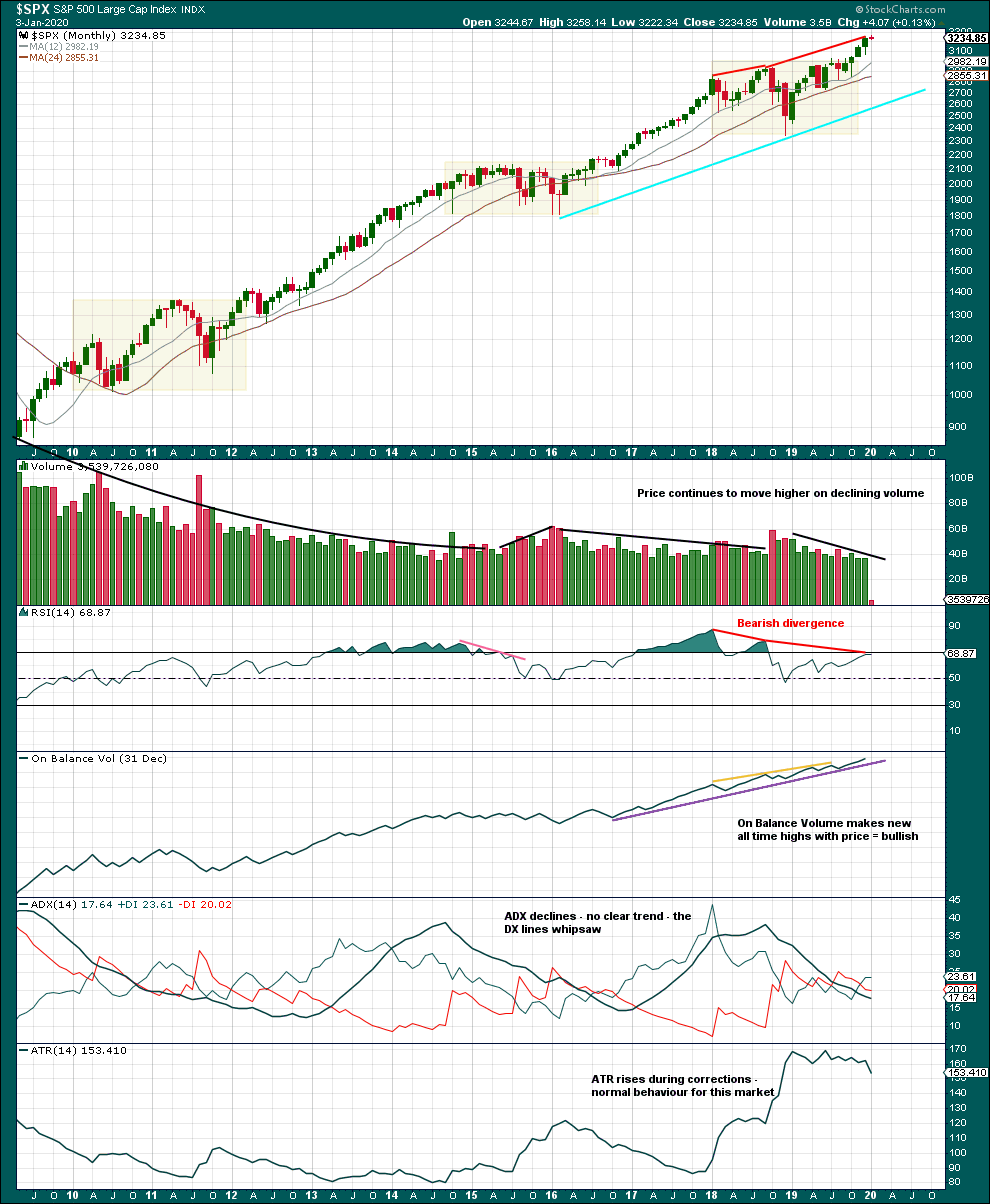
Click chart to enlarge. Chart courtesy of StockCharts.com.
There are three large consolidations noted on this chart, in shaded areas. After a breakout from a multi-month consolidation, it is reasonable to expect a multi month bullish move may result.
Note that in each of the first two cases a pullback saw price re-enter the consolidation zone after the breakout, before price then moved up and away. It is possible that may happen again after the last breakout from a consolidation.
This chart very clearly exhibits rising price on declining volume has now persisted for several years. A decline in volume last month, in current market conditions, is not of concern.
On Balance Volume supports the Elliott wave count.
WEEKLY CHART
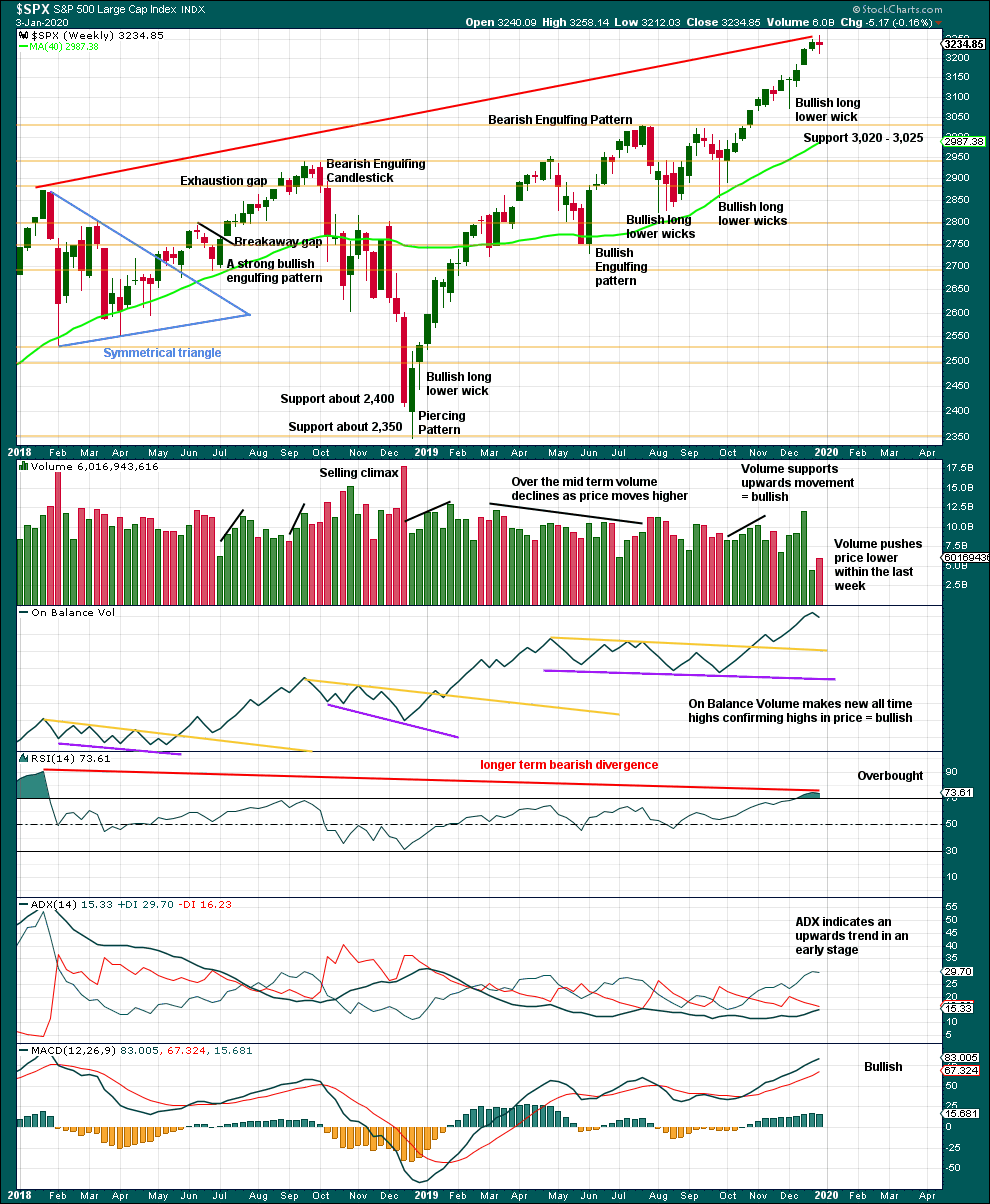
Click chart to enlarge. Chart courtesy of StockCharts.com.
It is very clear that the S&P is in an upwards trend and the bull market is continuing. Price does not move in straight lines; there will be pullbacks and consolidations along the way.
This chart is overall bullish. There are no signs of weakness in upwards movement.
RSI is now overbought. That does not mean upwards movement must end here, because it can continue for several weeks while RSI reaches more extreme. RSI reaching overbought is a warning that conditions are now becoming extreme. A pullback or consolidation will follow and the longer conditions are extreme the closer this will be. However, assume the trend remains the same until proven otherwise. This warning should be heeded by careful attention to risk management.
The doji last week on its own is not a reversal signal. It is a sign of a small pause.
DAILY CHART
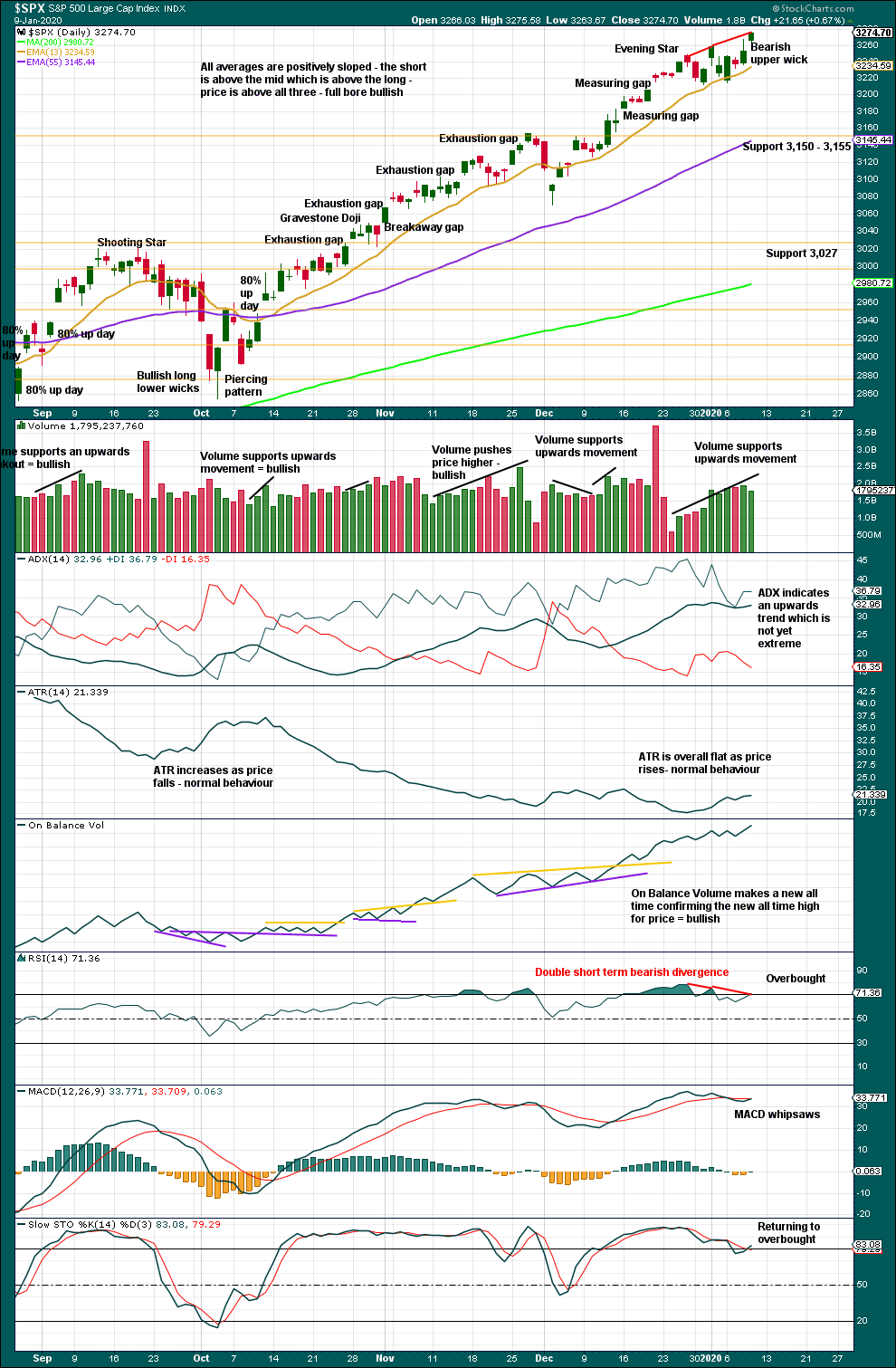
Click chart to enlarge. Chart courtesy of StockCharts.com.
There is an upwards trend in place. There will be corrections along the way.
Like the weekly chart, this chart is bullish.
RSI now exhibits double bearish divergence while overbought. This is often (not always) a warning of a pullback or consolidation to develop. Today the warning is slightly weakened but still evident.
Lowry’s data shows evidence of weakness in a rise of Selling Pressure by 4 points over the last few sessions. The risk here of a larger pullback or consolidation is increasing.
BREADTH – AD LINE
WEEKLY CHART
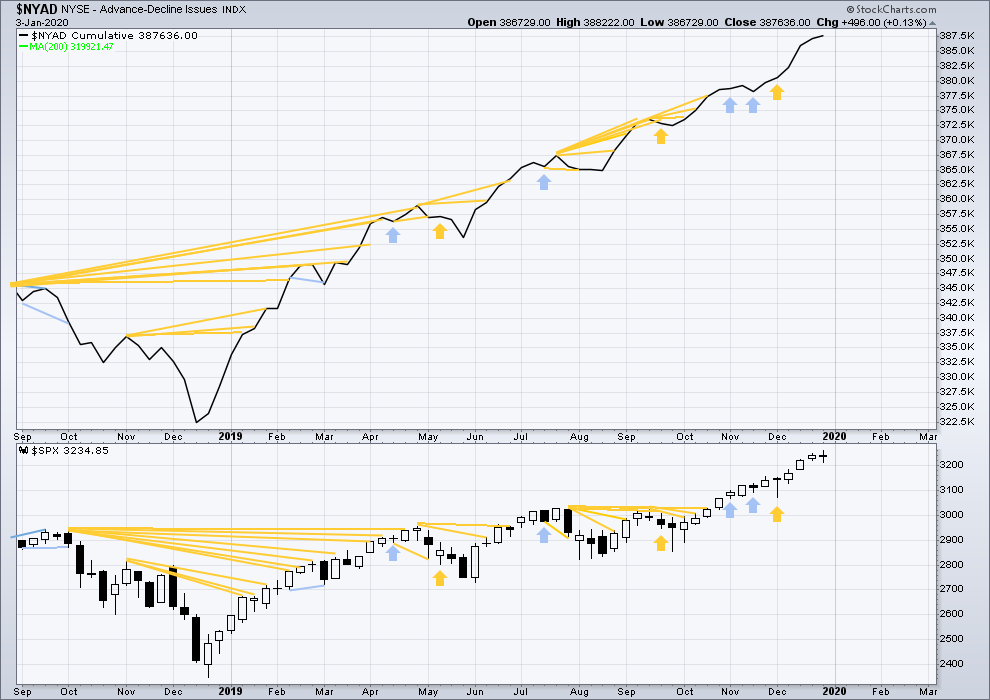
Click chart to enlarge. Chart courtesy of StockCharts.com. So that colour blind members are included, bearish signals
will be noted with blue and bullish signals with yellow.
Bear markets from the Great Depression and onwards have been preceded by an average minimum of 4 months divergence between price and the AD line with only two exceptions in 1946 and 1976. With the AD line making new all time highs this week, the end of this bull market and the start of a new bear market is very likely a minimum of 4 months away, which is the beginning of May 2020.
In all bear markets in the last 90 years there is some positive correlation (0.6022) between the length of bearish divergence and the depth of the following bear market. No to little divergence is correlated with more shallow bear markets. Longer divergence is correlated with deeper bear markets.
If a bear market does develop here, it comes after no bearish divergence. It would therefore more likely be shallow.
All of small, mid and large caps have made new swing highs above the prior swing high on the 13th of September, and mid caps have now made new all time highs. This upwards movement appears to be mostly driven by large caps, which is a feature of aged bull markets. This bull market at over 10 years duration certainly fits the definition of aged.
Again both price and the AD line have made new all time highs. There is no divergence. Upwards movement has support from rising market breadth.
Large caps all time high: 3,275.58 on 9th January 2020.
Mid caps all time high: 2,073.72 on 2nd January 2020.
Small caps all time high: 1,100.58 on 27th August 2018.
DAILY CHART
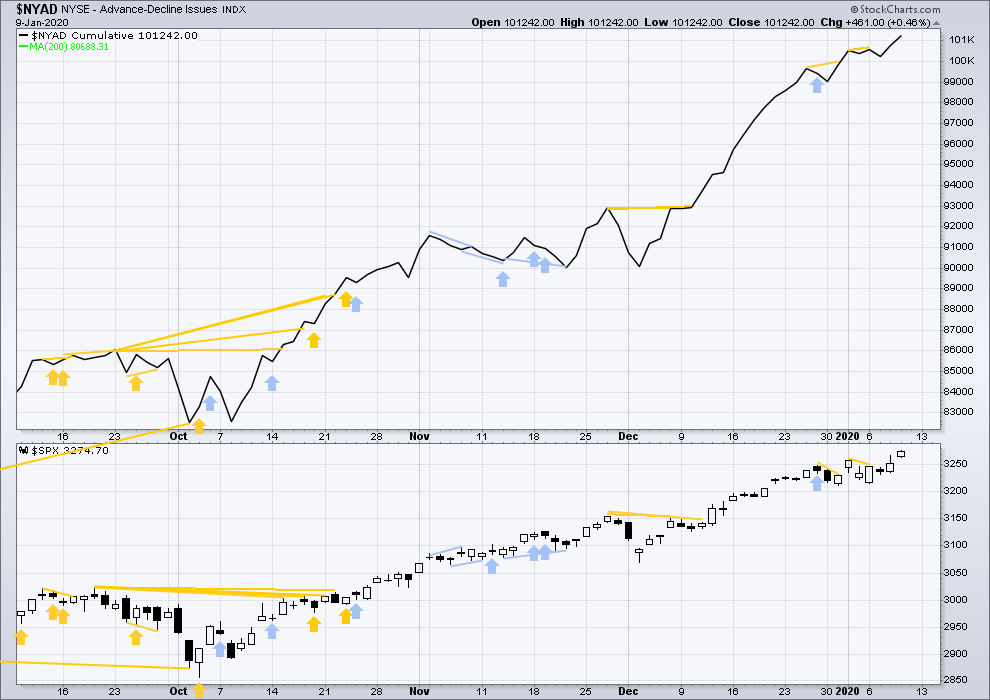
Click chart to enlarge. Chart courtesy of StockCharts.com. So that colour blind members are included, bearish signals
will be noted with blue and bullish signals with yellow.
Breadth should be read as a leading indicator.
Today both price and the AD line have again made new all time highs. There is no new divergence. There is now some selectivity in recent upwards movement: large caps are making new swing highs, but mid and small caps are not.
VOLATILITY – INVERTED VIX CHART
WEEKLY CHART
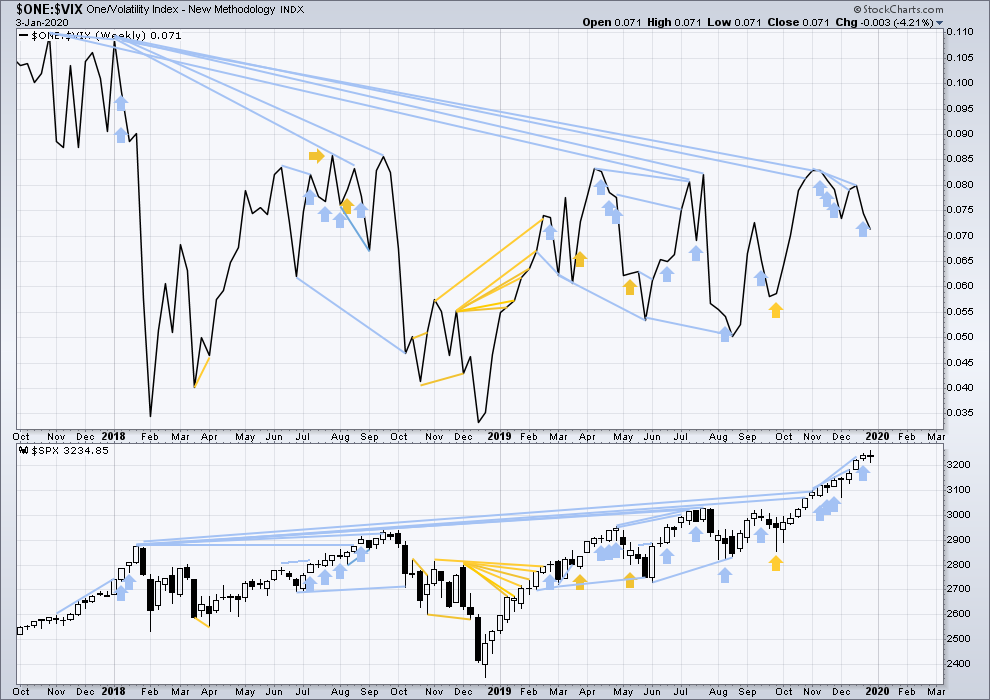
Click chart to enlarge. Chart courtesy of StockCharts.com. So that colour blind members are included, bearish signals
will be noted with blue and bullish signals with yellow.
The all time high for inverted VIX was on 30th October 2017. There is now over two years of bearish divergence between price and inverted VIX.
The rise in price is not coming with a normal corresponding decline in VIX; VIX remains elevated. This long-term divergence is bearish and may yet develop further as the bull market matures.
This divergence may be an early warning, a part of the process of a top developing that may take years. It may is clearly not useful in timing a trend change from bull to a fully fledged bear market.
Last week completes an outside week. Inverted VIX has declined during the week. There is no new short-term divergence.
DAILY CHART
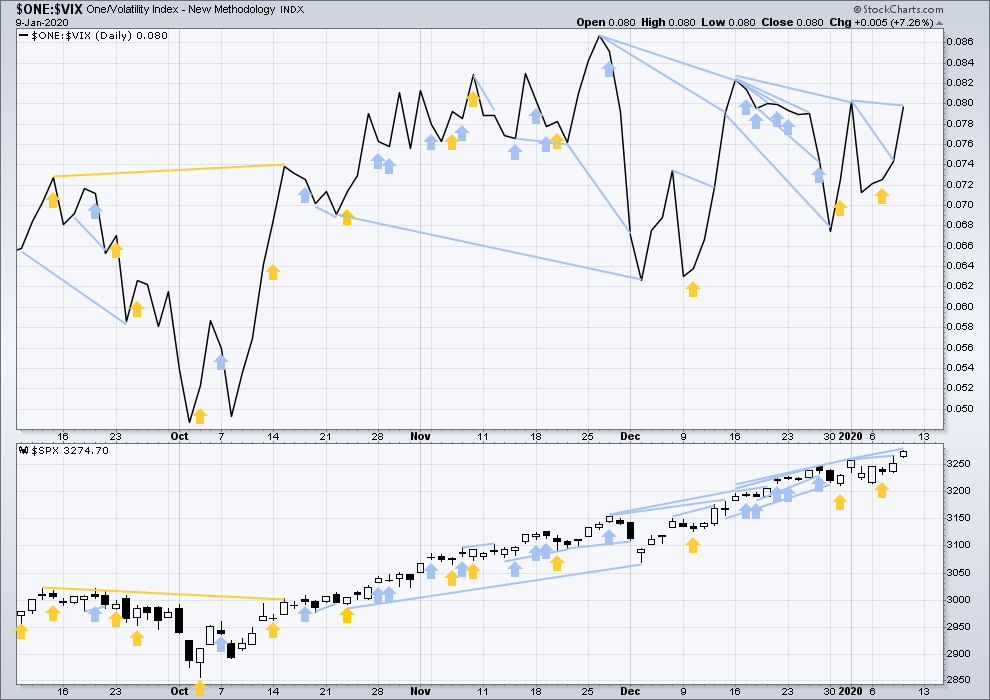
Click chart to enlarge. Chart courtesy of StockCharts.com. So that colour blind members are included, bearish signals
will be noted with blue and bullish signals with yellow.
Today both price and inverted VIX have moved higher. Price has made new highs, but there remains all of short, mid and long-term bearish divergence as inverted VIX has not made corresponding highs.
DOW THEORY
Dow Theory confirmed a bear market in December 2018. This does not necessarily mean a bear market at Grand Super Cycle degree though; Dow Theory makes no comment on Elliott wave counts. On the 25th of August 2015 Dow Theory also confirmed a bear market. The Elliott wave count sees that as part of cycle wave II. After Dow Theory confirmation of a bear market in August 2015, price went on to make new all time highs and the bull market continued.
DJIA: 23,344.52 – a close on the 19th of December at 23,284.97 confirms a bear market.
DJT: 9,806.79 – price has closed below this point on the 13th of December.
S&P500: 2,532.69 – a close on the 19th of December at 2,506.96 provides support to a bear market conclusion.
Nasdaq: 6,630.67 – a close on the 19th of December at 6,618.86 provides support to a bear market conclusion.
With all the indices having moved higher following a Dow Theory bear market confirmation, Dow Theory would confirm a bull market if the following highs are made:
DJIA: 26,951.81 – a close above this point has been made on the 3rd of July 2019.
DJT: 11,623.58 – to date DJT has failed to confirm an ongoing bull market.
S&P500: 2,940.91 – a close above this point was made on the 29th of April 2019.
Nasdaq: 8,133.30 – a close above this point was made on the 26th of April 2019.
Published @ 06:30 p.m. EST.
—
Careful risk management protects your trading account(s).
Follow my two Golden Rules:
1. Always trade with stops.
2. Risk only 1-5% of equity on any one trade.
—
New updates to this analysis are in bold.

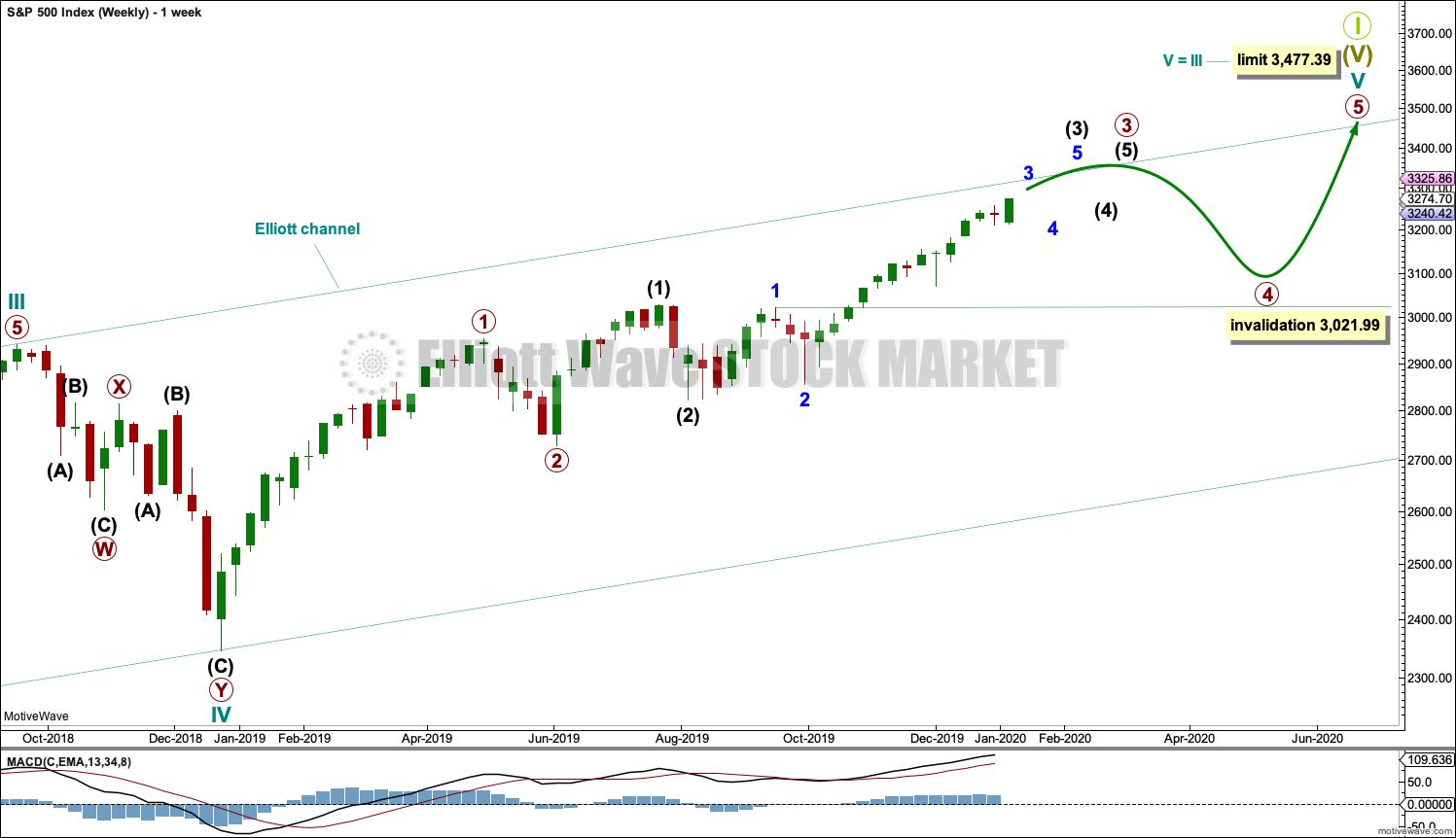
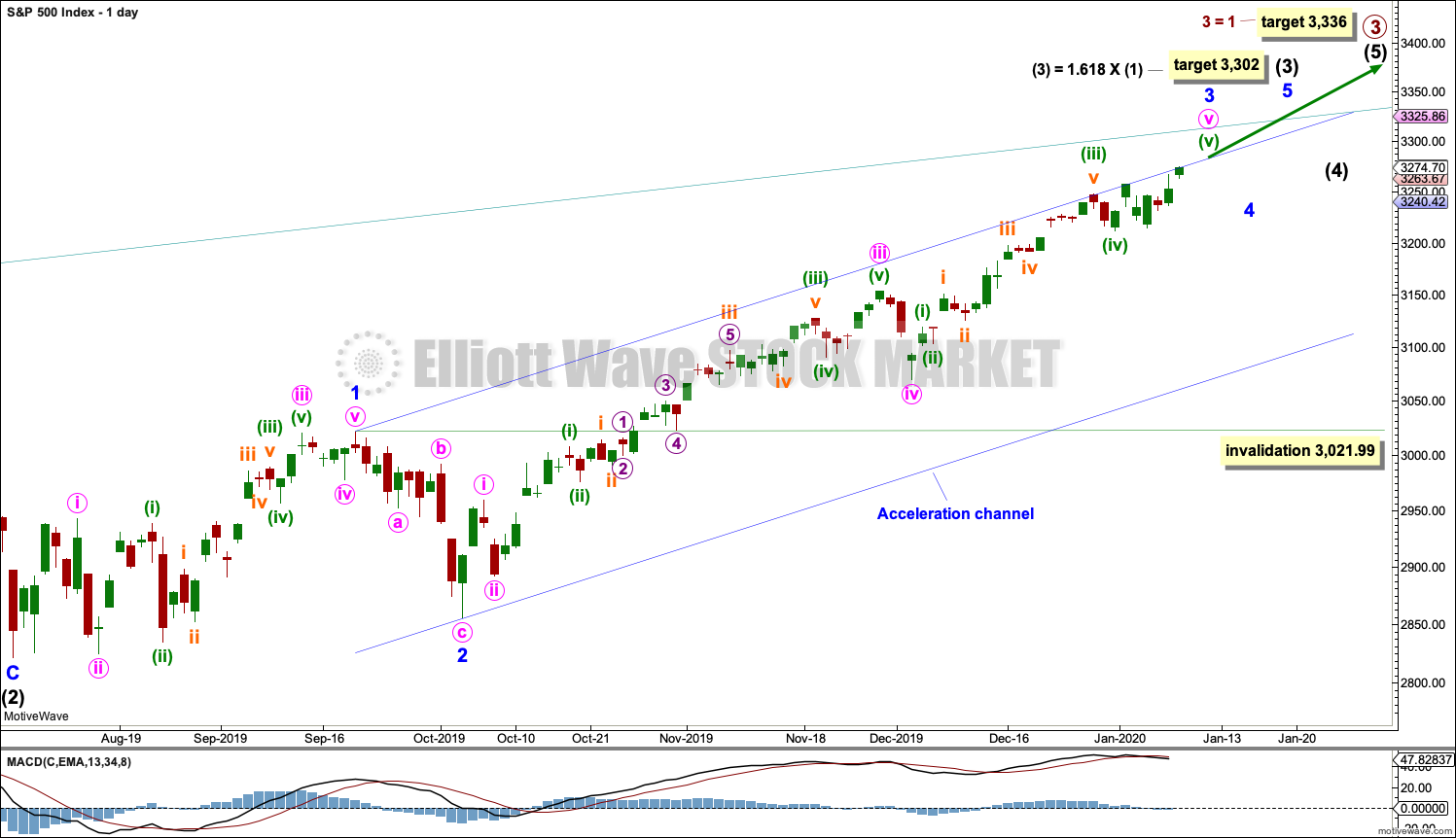
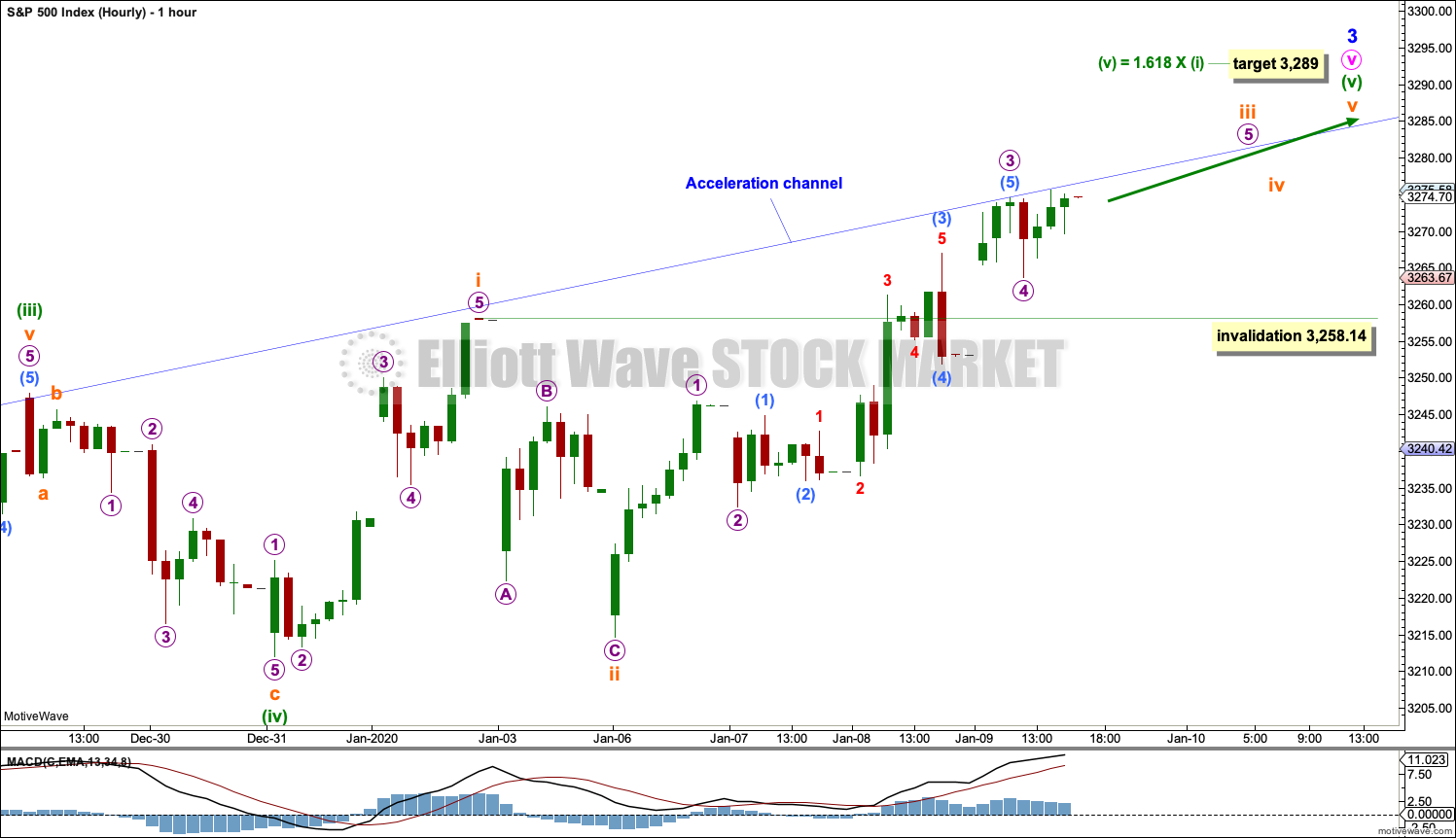

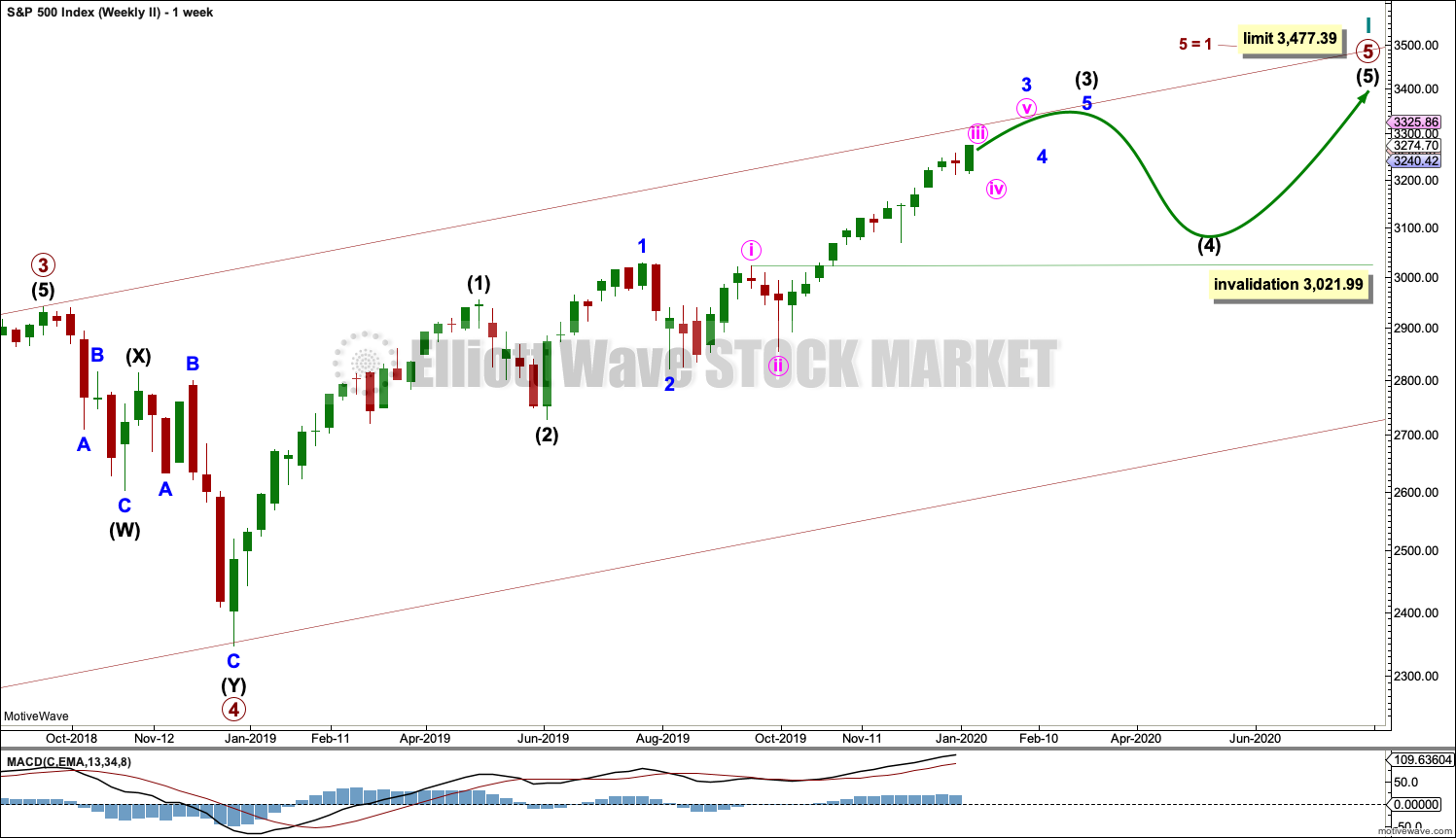
This is very interesting: ES price action after market by 5 pm EST when it closed ended right at 3263.50 (exactly the invalidation price for the ES to the tick). While we have to wait for SPX price action on Monday, I wonder if the first hourly bar on /ES closes below 3263.50 on Sunday when futures market opens, will it be a start of minor 4 or should it be confirmed by SPX action in normal Monday session?
To be safe, I’ll wait for the action on SPX.
I
What count are you referring to?
3263.50 is not an invalidation point on ES: there need to be 5 waves from the low of 3181 on 07-Jan. The first one ended at 3230, so that’s the ultimate invalidation point for current fourth wave.
Hourly chart updated:
Some sideways churn for another session may complete subminuette iv.
As long as price remains above the invalidation point this will be the main wave count.
Bullish RUT model. The minuette iv may be continuing instead of being finished. But popping above that pivot high (green line) is going to capture my attention.
that’s a possible a-b-c in place with a d in progress of a triangle btw…
I grabbed one more greedy bite long, as the wave count is looking for one more high…
Hi Peter-
per Laras hourly count- wouldn’t the high just after open have constituted as 3 – 3282.21, followed by the 4 – 3274ish at about 945 am, and with a slightly higher 5 – 3282.48 just after 10 am? pattern complete, no?
It doesn’t show up on the hourly chart but it sure is acting like it on the smaller time frames.
Now isn’t the worst time to buy up some vix calls. Down in the 12’s. A tiny spate of selling will jack that into the 13’s…and I’ll sell 1/3 of my position to de-risk, and look for more. I’m using Feb 21 strike 13 running between 290 and 300 (I paid 295).
An alternative “more bullish” wave count for the minor 3 to date for SPX (consistent with RUT count just below).
Comments, please.
The SPX and other indices can continue to march upwards. However, as a subscriber to EWSM I note certain things in Lara’s writings. Some such comments from today include:
—————————————————————————————————-
(From the Summary) The risk of a larger pullback or consolidation beginning here or very soon is now high.
Lowry’s data shows evidence of weakness in a rise of Selling Pressure by 4 points over the last few sessions. The risk here of a larger pullback or consolidation is increasing.
There is now some selectivity in recent upwards movement: large caps are making new swing highs, but mid and small caps are not. (My take: This is a sign of weakness or an unhealthy market.)
—————————————————————————————————–
We could add a few other things like daily MACD has not confirmed the new highs since December 27th. But why belabor the point. From the data at hand, we must note weakness in the US equity markets on a short term basis at least. Therefore, I am out. It is only the emotion of greed that wanted me to try to stay in for the last upside dollar. But like I said recently, that is like trying to pick up pennies and nickles in front of a moving steam roller. My long positions were in place since early October 2019 until just the past couple of days. In that time, SPX was up 10%. My position was the largest I have ever taken (I have never revealed the dollar amounts on the forum. But this trade was low six figures). So I had a wonderful profit. Now it is protected and I can rest my mind a bit as I await the next long position entry point because the Primary and Cycle trends are still up. In fact, the Intermediate trend is still up.
Can the SPX make an assault on 3400 and 3500 in the next month or two for no apparent reason? Yes, it can. But I did not want to hold out for that possibility as risk of a correction towards 3150-3100 increases day by day.
Just my thoughts. Each trader / investor must make his/her own plan and strategy as well as execution of the plan.
I value your perspective Rodney (and congrats on the exceptional long through this minor 3; well played!). I appreciate that not all the technicals support this more bullish count. But those can quickly change. My question is more in the realm of is this alternative count legitimate. I’ll accept out of the chute that it’s lower in probability than Lara’s main. I always strive to consider viable alternatives.
The count looks legitimate to me. But what do I know about EW.
If you recall, for some time I have preferred one of Lara’s monthly alternates which exceed the SPX 3477 limit on the current preferred monthly count. But the market never makes it easy. We might just go to 3450 before a larger correction but not invalidating the current count. Then we will not know which is correct for some long time.
Gotta run. I’ve been burning the candle at both ends for three months now. I’ve only had a couple of days off in that time. Granted some of my days are shorter half days. But nonetheless, I am due for some break time!
Rest for the wicked, good idea!
GO 49er’s!!!!!!!!!!!!!!!!!!!!!!!!!!!!!!!!!!!!!!!
Here’s an alternative, yet more bullish model for RUT.
AAPL, along with broader market, showing signs of being “close” to starting a significant correction. Any constructive criticism of this WC is very welcome!
Another service just put$325+ target with ramp into $400s for Apple in 12 months or so. I am surprised myself as things are so out of whack with reality.
I was just looking at NFLX. Look at the monthly. Sure looks like a very large triangle in development to me!!! The current swing up from Sept is wave D. The 358-361 area is the 76-78% retrace zone, and a very likely turn zone if the triangle structure is accurate. And then after an E down, back to the upside races. But I sure wouldn’t want to get too long right here and now yet, unless I was playing for just the move from the 333 area to the 360 area.
Shopify is another stock that just makes no sense but as long as investor are willing to pay…price will ramp higher. I am watching NFLX and FB very closely.
/ES overnight (hourly here) tagged and turned off the 127.2% extension of the subminuette i, and scribbled on my “next up” Fibonacci projection.
While I’m suspicious the gig is up that’s been true for two weeks so…confirmation, confirmation, confirmation.
John Carter states 4/5 times, when the week before options expiration week is an up week, the options expiration week (next week) is a down week. Though he doesn’t give hard data, just “in his experience”.
What have we here??